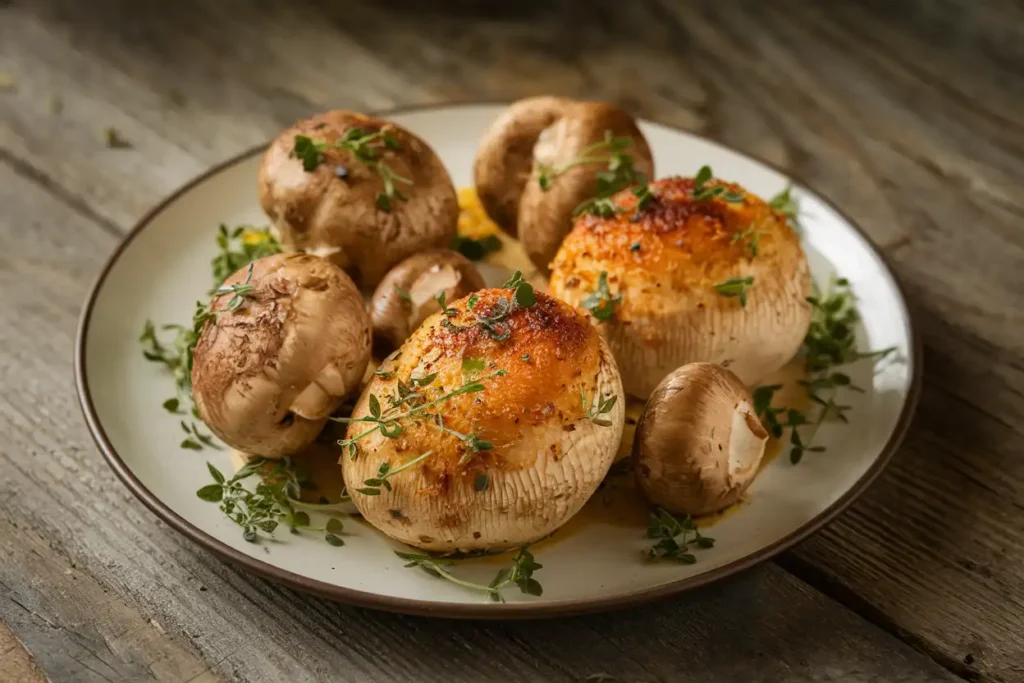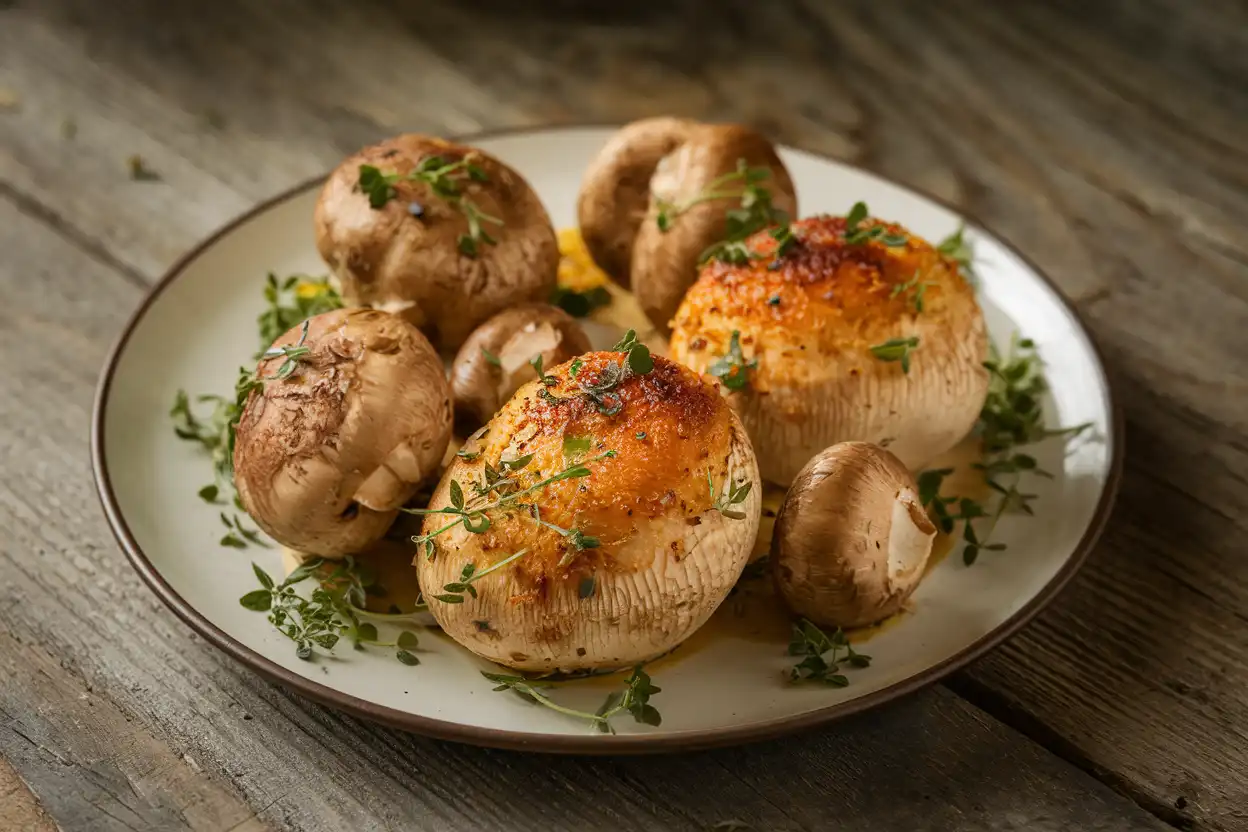If you’re curious about edible mushrooms, you’ve likely heard of Chicken of the Woods. This mushroom is so unique that its taste often surprises even experienced foragers. It’s a bright, fan-shaped mushroom that’s popular with foragers and chefs alike. Known for its meaty texture and chicken-like flavor, it’s a favorite in wild food circles. But what exactly does Chicken of the Woods taste like? And why do so many people seek it out?
In this guide, we’ll cover everything you need to know about Chicken of the Woods: its taste profile, cooking methods, and why it’s great for plant-based dishes. This mushroom doesn’t just offer a unique culinary experience; it’s also packed with nutrients. Curious how to cook it like a pro? Let’s dive in and explore the world of wild, delicious flavors.
What is Chicken of the Woods?
Getting to Know the Mushroom
Chicken of the Woods, scientifically called Laetiporus sulphureus, is a unique mushroom species that grows on hardwood trees. Its vibrant orange and yellow colors make it a forager’s delight. In this Chicken of the Woods Taste and Cooking Guide, we’ll cover its taste profile, nutritional value, and how to safely prepare it.
Unlike other mushrooms, it has no gills underneath but instead has a smooth, sponge-like surface. It’s famous for its chicken-like texture and taste, making it popular in plant-based cooking. Interested in how to identify and prepare this mushroom? This Complete Guide to Chicken of the Woods Mushrooms is a great resource.
Commonly found in North America and parts of Europe, this mushroom typically grows from late spring to early autumn in wooded areas. However, correct identification is essential, as some look-alikes are toxic. If you’re ready to cook up your find, this Guide to Cooking Chicken of the Woods offers detailed tips on safe preparation.
Flavor Profile and Texture of Chicken of the Woods
The Unique Taste and Texture
The Chicken of the Woods Taste and Cooking Guide wouldn’t be complete without a look at this mushroom’s unique flavor and texture. Often compared to chicken in taste and texture, it provides a dense, meaty chew. Depending on where it’s grown, some people notice seafood-like hints, such as crab or lobster, especially when cooked with lemon juice.
One of the most unique aspects of Chicken of the Woods is its texture. When cooked, it has a dense, fibrous structure that resembles meat, which isn’t common for most mushrooms. This mushroom has a solid, satisfying bite that works well in stir-fries, sautés, and even grilled dishes. Depending on where it’s grown and how it’s prepared, some people notice seafood-like hints, such as crab or lobster, especially when cooked with lemon juice or butter. Others taste a slight lemony flavor or even a faint woodiness.
Taste Variability Based on Environment
The environment influences the flavor profile of Chicken of the Woods. Mushrooms growing on oak trees may have a deeper, earthier flavor, while those found on pine can sometimes carry a slight piney bitterness.
To enjoy its natural taste, cook it with minimal seasoning. But, if you’re aiming for a richer profile, try adding herbs like thyme, rosemary, or garlic to enhance its savory notes. Experimenting with different cooking methods can reveal a range of flavors, making each dish a new adventure.
Cooking Techniques for Enhancing Flavor

Top Methods for Cooking Chicken of the Woods
Cooking Chicken of the Woods is a rewarding experience. The key in this Chicken of the Woods Taste and Cooking Guide is to bring out its savory flavors while keeping its tender, chewy texture. Here are some of the best methods for cooking it to enhance its chicken-like qualities.:
- Sautéing: Sautéing in olive oil or butter can bring out a rich, golden-brown finish. Cook on medium heat, then season with salt, pepper, and garlic. Add a splash of lemon juice for extra flavor.
- Grilling: For a smokier taste, marinate the mushroom slices in olive oil, lemon juice, and herbs before grilling. Grilling adds a charred, smoky flavor that balances its natural mildness.
- Breading and Frying: Bread the mushroom in a breadcrumb mix, then fry it like a chicken cutlet. This creates a crispy outer layer, especially tasty with smoked paprika or cayenne for a hint of spice.
- Braising: If you prefer a softer texture, braise the mushroom in a broth with onions, garlic, and thyme. Braising is ideal for soups and stews and brings out a deeper, more savory flavor.
Seasoning and Pairing Tips
Pairing is essential for Chicken of the Woods. The mushroom’s mildness makes it versatile, so try complementary flavors. A touch of smoked paprika, cayenne, or black pepper gives it a gentle spice, while lemon or lime adds brightness. Pairing it with potatoes, rice, or crusty bread creates a heartier dish.
For a quick, flavorful dish, sauté slices with garlic, fresh thyme, and soy sauce. Or, use it as a meat substitute in a stir-fry or pasta. The possibilities are endless, making this mushroom an exciting ingredient to explore.
Comparing Chicken of the Woods to Real Chicken
Why It’s Called Chicken of the Woods
Chicken of the Woods didn’t get its name by accident! The mushroom’s flavor and texture resemble chicken enough to satisfy even meat lovers. But does it really taste like chicken? The answer varies, but the resemblance is close, especially when seasoned and cooked in similar ways.
In terms of texture, it’s similar to well-cooked chicken breast. It has a dense, fibrous structure that’s surprisingly satisfying. Imagine the tender chewiness of grilled chicken strips — that’s what you can expect with this mushroom. This similarity has made it a favorite for vegetarians and vegans as a meat substitute in stir-fries, tacos, and soups.
For those curious about plant-based eating or reducing meat intake, this mushroom is an ideal alternative. Its flavor and texture make it a perfect substitute in recipes, providing a satisfying bite and a robust flavor that’s hard to find in other substitutes. If you’re ready to experiment, check out some Chicken of the Woods recipes to get started.
Nutritional Profile and Health Benefits of Chicken of the Woods
Why It’s Nutritious and How It Supports Health
One of the reasons Chicken of the Woods has earned a spot in many kitchens is its impressive nutritional profile. This mushroom is not only tasty but also a good source of essential nutrients, making it an appealing choice for both foodies and health-conscious eaters. While it might not replace the protein punch found in chicken, it provides a surprisingly nutritious boost that can complement a balanced diet.
Key Nutrients
Chicken of the Woods is particularly high in fiber, aiding digestion and promoting a healthy gut. It also contains moderate amounts of protein, making it a popular substitute for meat in vegetarian and vegan diets. Additionally, it’s rich in essential vitamins and minerals, such as B vitamins (important for energy and cell health) and potassium, which helps maintain muscle and nerve function. The mushroom also provides antioxidants, which help combat oxidative stress and may support immune health.
Health Benefits
Eating Chicken of the Woods may offer several health benefits. Its high fiber content can contribute to healthy digestion, while the antioxidants support immune function and may reduce inflammation. Plus, the protein content helps maintain muscle mass, particularly beneficial for those following a plant-based diet. The presence of potassium also means it supports heart health by regulating blood pressure. This mushroom is a true example of food that’s as good for your body as it is for your taste buds.
Want to learn more about nutrient-rich recipes? Check out our Best Ways to Cook Chicken of the Woods to incorporate this mushroom into a healthy meal plan.
Safety and Precautions When Foraging
Foraging and Preparing Safely
Foraging for Chicken of the Woods can be a rewarding experience, but it’s essential to approach it with caution. Like all wild mushrooms, correct identification is crucial to avoid potentially harmful look-alikes. While Chicken of the Woods is generally safe, some people experience mild digestive upset, especially when trying it for the first time.
Key Safety Tips
- Accurate Identification: Chicken of the Woods is easy to recognize, but it’s always wise to consult a guidebook or go with an experienced forager if you’re a beginner. The mushroom has some look-alikes, such as sulfur shelf mushrooms, which can be toxic.
- Harvesting Young Specimens: Older mushrooms tend to be tougher and can cause digestive issues for some people. Look for young, vibrant specimens with bright orange and yellow colors.
- Cooking Thoroughly: Avoid eating this mushroom raw, as it can cause stomach upset. Cooking thoroughly can help reduce the risk of digestive issues and also bring out the best in its flavor and texture.
- Testing in Small Amounts: When trying Chicken of the Woods for the first time, eat a small amount to check for any adverse reactions. Some people are sensitive to certain wild mushrooms and may experience mild allergic responses.
By following these tips, you can safely enjoy this mushroom’s unique taste without worries. Curious to try cooking it? For more details on preparation, explore our guide on Preparing Chicken of the Woods Mushroom.
Frequently Asked Questions About Chicken of the Woods
Common Questions Answered
Many people have questions about Chicken of the Woods before giving it a try. Here are some of the most common FAQs about this fascinating mushroom:
- Is Chicken of the Woods Safe to Eat Raw?
No, it’s generally not recommended to eat Chicken of the Woods raw. Eating it uncooked can cause digestive discomfort. Cooking it thoroughly not only enhances its flavor but also makes it safer to consume. - How Should I Store Chicken of the Woods?
To keep it fresh, store Chicken of the Woods in a paper bag in the refrigerator. It should last up to a week, though it’s best enjoyed within a few days of harvesting. You can also freeze it after blanching for longer storage. - What’s the Best Way to Cook Chicken of the Woods?
This mushroom is versatile, but sautéing, frying, and grilling are popular methods. Each brings out different flavor notes, allowing you to experiment and find your favorite way to enjoy it. - How Does Chicken of the Woods Differ from Hen of the Woods?
These mushrooms are quite different despite their similar names. Hen of the Woods has a delicate, earthy flavor and a frillier appearance. Chicken of the Woods, on the other hand, is dense and savory with a meaty texture. - Are There Any Side Effects of Eating Chicken of the Woods?
Most people enjoy it without issue, but some may experience mild stomach upset or allergic reactions. Always start with a small amount if it’s your first time trying this mushroom.
For anyone new to foraging or cooking with wild mushrooms, these answers can help guide a safe and delicious experience.
Conclusion

Summing It Up: Flavor, Nutrition, and Safety
Chicken of the Woods is a true treasure of the forest. Its chicken-like taste and texture make it a popular choice for plant-based meals, while its impressive nutritional profile adds to its appeal. Whether you’re using it as a chicken substitute or simply enjoying its unique flavor, this mushroom offers a rewarding culinary experience.
However, as with any wild food, safety is paramount. Accurate identification, proper preparation, and cautious foraging are essential steps. With the right approach, you can savor Chicken of the Woods without worry, enjoying both its flavor and health benefits.
Ready to bring this mushroom into your kitchen? Try exploring our Chicken of the Woods Recipe for inspiration, and start enjoying the unique taste of this amazing mushroom!
